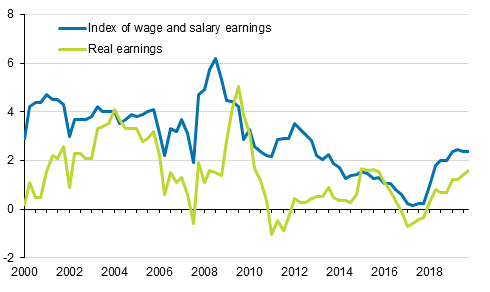Published: 6 February 2020
Index of wage and salary earnings rose by 2.4 percent in October-December
According to preliminary data of Statistics Finland, the nominal earnings of wage and salary earners rose by 2.4 per cent in October to December 2019 when compared with the respective period in 2018. Real earnings rose by 1.6 per cent compared to the fourth quarter of the previous year, because the rise in earnings level was faster than that in consumer prices.
Index of wage and salary earnings and real earnings 2000/1 to 2019/4, annual change percentage

According to Statistics Finland’s preliminary data, the nominal earnings of wage and salary earners rose from October to December 2018 to the corresponding period in 2019 by 2.0 per cent in the private sector, by 3.2 per cent in the central government sector and by 3.3 per cent in the local government sector.
Compared to the year before, the average increase in the level of earnings during 2019 was 2.4 per cent, whereas the increase in real earnings was 1.4 per cent according to preliminary data.
Wage and salary earners’ regular earnings increased by 2.2 per cent in October to December
The index for regular earnings describes the permanent change in earnings better than the index of wage and salary earnings because it does not take into account performance-based bonuses and non-recurring items included in collective agreements. Regular earnings rose by 2.2 per cent in October to December 2019 when compared with the respective period in 2018. The growth amounted to 2.1 per cent in the private sector, to 2.5 per cent in the central government sector, and to 2.6 per cent in the local government sector.
Index of wage and salary earnings and index of regular earnings are final as far as the year 2018
The indices of wage and salary earnings and the indices for regular earnings are final until 2018. They are based on the realised earnings development. The indices for 2019 are preliminary and they are based on estimates of agreement effects and the wage drift. In addition, the data on performance-based bonuses of the Labour Cost Index are used to assess performance-based bonuses in the calculation of the preliminary indices of the index of wage and salary earning.
Source: Index of wage and salary earnings 2019, 4th quarter. Statistics Finland
Inquiries: Anu Uuttu 029 551 2322, Harri Nummila 029 551 3235, palkat.indeksit@stat.fi
Director in charge: Mari Ylä-Jarkko
Publication in pdf-format (442.4 kB)
- Tables
-
Tables in databases
Pick the data you need into tables, view the data as graphs, or download the data for your use.
Appendix tables
- Appendix table 1. Index of wage and salary earnings 2015=100 by employer sector and base of payment (6.2.2020)
- Appendix table 2. Index of regular earnings 2015=100 by employer sector and base of payment (6.2.2020)
- Appendix table 3. Index of wage and salary earnings 2015=100 by employer sector and gender (6.2.2020)
- Appendix table 4. Index of regular earnings 2015=100 by employer sector and gender (6.2.2020)
- Appendix table 5. Index of wage and salary earnings 2015=100 by industry, (TOL 2008) (6.2.2020)
- Appendix table 6. Index of regular earnings 2015=100 by industry, (TOL 2008) (6.2.2020)
- Appendix table 7. Index of wage and salary earnings 2010=100 by employer sector and gender (6.2.2020)
- Appendix table 8. Index of wage and salary earnings 2010=100 by industry, (TOL 2008) (6.2.2020)
- Appendix table 9. Index of wage and salary earnings 2015=100, percentage changes (6.2.2020)
- Appendix table 10. Index of regular earnings 2015=100, percentage changes (6.2.2020)
- Appendix table 11. Average earnings by employer sector and gender, EUR/month (6.2.2020)
- Revisions in these statistics
-
- Revisions in these statistics (6.2.2020)
Updated 6.2.2020
Official Statistics of Finland (OSF):
Index of wage and salary earnings [e-publication].
ISSN=1798-7814. 4th quarter 2019. Helsinki: Statistics Finland [referred: 14.12.2025].
Access method: http://stat.fi/til/ati/2019/04/ati_2019_04_2020-02-06_tie_001_en.html

